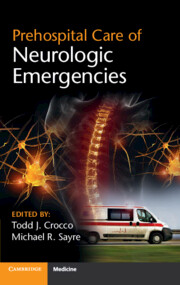
-
Select format
-
- Publisher:
- Cambridge University Press
- Publication date:
- August 2014
- July 2014
- ISBN:
- 9781139629058
- 9781107678323
- Dimensions:
- Weight & Pages:
- Dimensions:
- (186 x 123 mm)
- Weight & Pages:
- 0.22kg, 200 Pages
You may already have access via personal or institutional login
Book description
Prehospital Care of Neurologic Emergencies is a reliable and definitive resource for emergency medical services personnel at multiple levels: physicians, paramedics, nurses and others who encounter these critically ill patients. This focused and succinct book addresses the management of a wide range of neurologic emergencies, including traumatic brain injuries, spinal cord injuries, strokes, and seizures. In these emergencies time is critical, and the simply presented, straightforward format of the patient care and management recommendations help readers to treat patients rapidly and confidently. Each chapter follows a standard format that includes an overview of each neurologic emergency, important background, key challenges, and areas requiring future investigation. This book is unlikely to be placed on your bookshelf; instead, you will keep it nearby for times when you face life-threatening neurologic emergencies. When seconds count, this book has the answers.
Contents
Metrics
Full text views
Full text views help Loading metrics...
Loading metrics...
* Views captured on Cambridge Core between #date#. This data will be updated every 24 hours.
Usage data cannot currently be displayed.
Accessibility standard: Unknown
Why this information is here
This section outlines the accessibility features of this content - including support for screen readers, full keyboard navigation and high-contrast display options. This may not be relevant for you.
Accessibility Information
Accessibility compliance for the PDF of this book is currently unknown and may be updated in the future.

